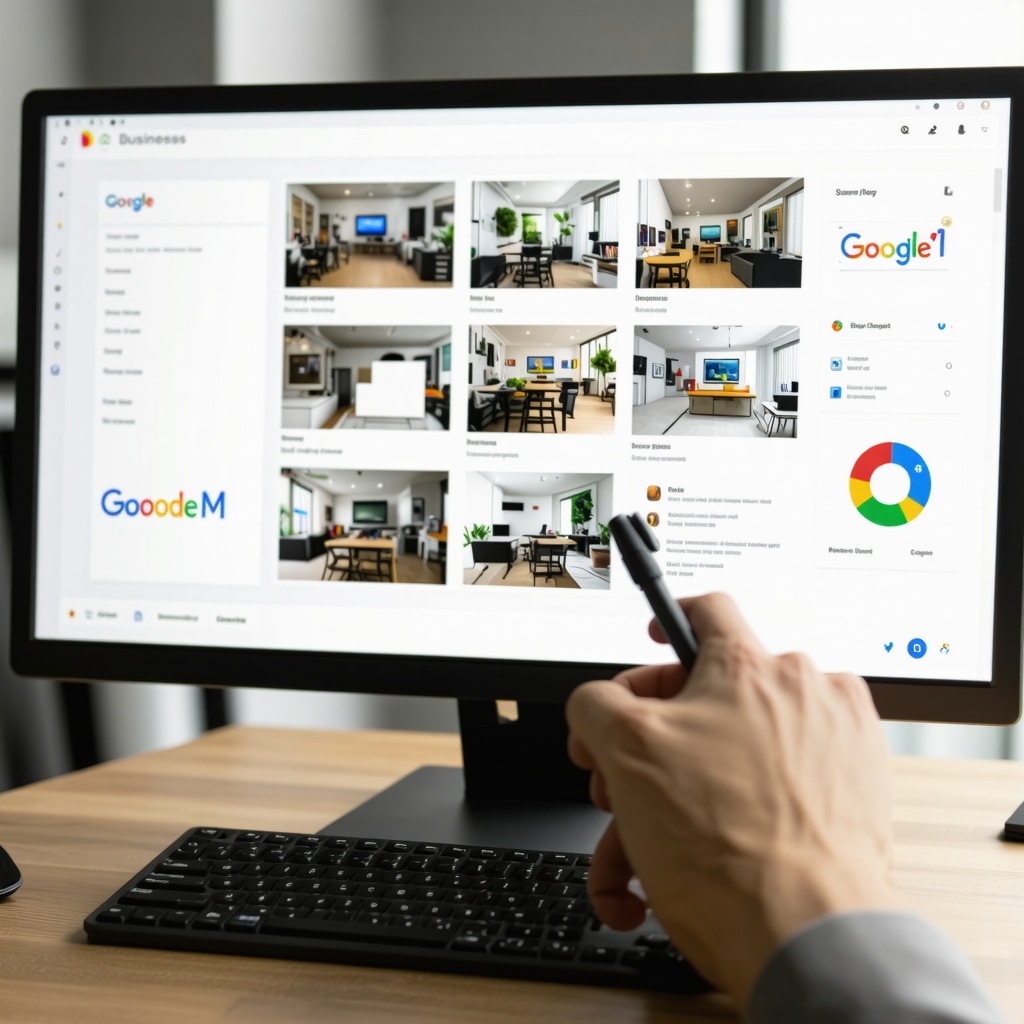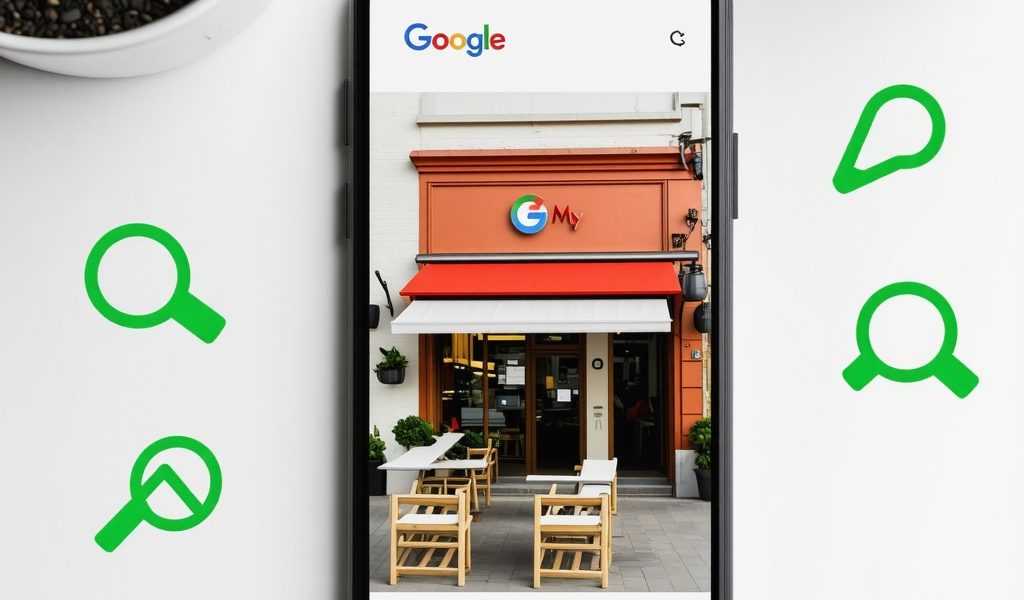Capturing Success: Why Optimizing Your GMB Photos Transforms Local SEO
In the bustling realm of local search, your Google My Business (GMB) profile’s photos are often the first impression potential customers encounter. But beyond mere aesthetics, these images wield significant influence over your local SEO performance. Optimizing GMB photos is an art and science that can elevate your visibility in local packs and Google Maps, driving more foot traffic and engagement to your business.
Visual Storytelling: Crafting a Compelling Photo Narrative for Your GMB Listing
Images on your GMB profile should do more than showcase products or premises; they must tell a story that resonates with local customers. High-resolution photos that highlight your unique selling points, authentic customer interactions, and your business atmosphere create a trustworthy digital persona. For example, a local café could feature vibrant shots of its cozy interior, freshly brewed coffee, and happy patrons, making it relatable and inviting.
How Can Strategic Photo Optimization Elevate Your Local Search Rankings?
Google’s algorithm increasingly factors in user engagement signals, including photo quality and relevance. By uploading optimized images — with descriptive filenames and alt text incorporating local keywords — you signal to Google that your business is active and relevant. Consistently updating photos also fosters higher user interaction, which can improve click-through rates and rankings. According to Google’s own guidelines on image SEO, these practices help search engines better understand and index your visual content.
Technical Mastery: Photo Specifications That Make or Break Your GMB Optimization
Understanding the technical parameters is crucial. Google recommends photos to be at least 720px wide by 720px tall with a file size under 5MB to ensure fast loading and crisp display. Use JPEG or PNG formats for optimal quality and compression balance. Moreover, geotagging your images with GPS coordinates can enhance local relevance, anchoring your photos directly to your business location.
Consistency and Authenticity: The Twin Pillars of GMB Photo Excellence
Authenticity breeds trust. Avoid stock photos that can dilute your brand’s uniqueness. Instead, maintain a consistent style and color palette that aligns with your branding. Regularly updating your photo gallery with seasonal images, new products, or behind-the-scenes glimpses keeps your listing fresh and engaging. This continuous authenticity signals to Google that your business is active, which is a positive ranking factor.
Practical Insights: Leveraging User-Generated Content and Photo Reviews
Encouraging customers to upload their photos not only enriches your GMB profile but also enhances social proof. User-generated images often carry genuine context that prospective clients find trustworthy. Integrate photo review strategies into your local SEO plan to boost engagement metrics. For further tactics on leveraging customer reviews alongside photos, explore our detailed guide on GMB review generation best practices.
Ready to transform your local business presence through expert photo optimization? Share your experiences or questions below and join the conversation to unlock more advanced local SEO strategies.
Beyond Basics: Advanced Techniques for GMB Photo Optimization
While high-quality photos and proper formatting lay the foundation for a strong Google My Business presence, advanced optimization techniques differentiate truly authoritative local listings. Incorporating strategic image metadata, leveraging schema markup, and prioritizing mobile-friendly content delivery can substantially boost your local SEO performance.
For instance, embedding structured data such as ImageObject schema with accurate licensing, captions, and geo-coordinates helps search engines contextualize your images more effectively. This not only improves indexing but also supports eligibility for rich results, increasing your visibility. Google’s official documentation provides in-depth guidance on implementing these practices.
Harnessing the Power of Seasonal and Event-Driven Photo Updates
Dynamic photo content aligned with local events or seasons signals an active and engaged business to Google and your audience. For example, a retail store showcasing holiday promotions or a restaurant highlighting a summer menu update creates relevance and freshness, which are positive SEO signals. Moreover, it enhances user experience by reflecting timely offerings.
Integrate a photo update calendar into your local SEO strategy to consistently refresh your GMB gallery. This tactic complements other local SEO efforts, like citation management and review generation, consolidating your ranking advantages. Explore our best practices for GMB citation management to maintain overall profile consistency.
How Can Optimized GMB Photos Influence User Behavior and Conversion Rates?
Beyond rankings, optimized photos directly impact user engagement metrics — crucial signals that Google interprets as indicators of quality and relevance. High-resolution, contextually relevant images enhance click-through rates, time spent on your profile, and even physical visits. A study by BrightLocal found that businesses with photos receive 42% more requests for directions and 35% more click-throughs to their websites compared to those without photos.
Understanding this user behavior dynamic encourages businesses to invest in authentic, optimized photographic content that not only attracts clicks but fosters conversions. Visit our guide on optimizing your Google Business listing to learn how photo optimization fits within a holistic local SEO approach.
Integrating User-Generated Content with Strategic Photo Curation
While encouraging customers to upload photos is beneficial, curating and responding to user-generated content further amplifies trust and engagement. Moderating and showcasing the best customer images, especially those that highlight unique product usage or location features, complements your official gallery and diversifies visual storytelling.
Employ a systematic approach to photo review requests and incentivize uploads through campaigns or contests. This not only increases fresh content but also generates authentic social proof, a critical factor in local search rankings and consumer decision-making.
For comprehensive tactics on managing user reviews alongside photos, check out our detailed resource on GMB review generation best practices.
Have you tested any of these advanced GMB photo strategies? Share your insights or questions in the comments below to help local businesses master visual SEO and gain competitive edge.
Geo-Targeted Photo Metadata: Unlocking Hyperlocal SEO Potential
Beyond basic geotagging, integrating precise GPS coordinates within your image metadata can dramatically enhance your GMB photo optimization. This hyperlocal approach allows search engines to associate your images directly with your physical location, improving local relevance signals. Tools like Adobe Lightroom or specialized EXIF editors enable businesses to embed exact latitude and longitude data, reinforcing your presence in neighborhood-specific searches.
Moreover, pairing geo-targeted metadata with localized keywords in filenames and alt attributes fortifies your image SEO. For instance, a boutique in Brooklyn might name a photo as “brooklyn-boutique-window-display.jpg” rather than generic titles. This synergy of metadata and textual optimization signals to Google that your content is not only high quality but location-specific, an essential factor in competitive local search landscapes.
What Are the Best Practices for Embedding and Managing Geo-Coordinates in GMB Photos?
Effective management of geo-coordinates involves more than merely adding GPS data. It requires consistency across all images and alignment with your business’s verified address. Inconsistent or inaccurate coordinates can confuse search algorithms and undermine local SEO efforts.
Best practices include:
- Use reliable tools to embed GPS data: Employ professional image editing software or EXIF metadata editors that allow precise coordinate insertion.
- Maintain uniformity: Ensure all photos share consistent geo-coordinates reflecting your business location.
- Regular audits: Periodically verify metadata integrity to prevent corruption or accidental removal during image processing.
- Complement with structured data: Utilize ImageObject schema markup that includes geo-coordinates and licensing information to aid search engine interpretation.
Adhering to these methods not only improves your GMB listing’s local search footprint but also enhances eligibility for Google’s rich results, driving higher engagement and trust.
Leveraging Structured Data for Image SEO: Beyond the Basics
While many businesses implement basic image optimization, leveraging advanced structured data can elevate your GMB photos’ discoverability. Embedding comprehensive ImageObject schema with detailed attributes — such as caption, licensing, upload date, and geo-coordinates — provides nuanced context to search engines.
This granular data assists Google in understanding your images’ purpose, authenticity, and relevance, which can contribute to enhanced SERP features like image carousels or knowledge panels. Furthermore, integrating schema markup into your GMB website and associated content ensures a cohesive SEO strategy that amplifies your local presence.
For detailed technical guidance, refer to Google’s authoritative resource on Image License Metadata, which outlines best practices for schema implementation.
Photo Load Speed Optimization: Balancing Quality and Performance for Mobile Users
In an era dominated by mobile search, photo load times significantly impact both user experience and SEO. High-resolution images can enhance visual appeal but may hinder page speed if not optimized correctly. Employing techniques such as adaptive image serving, responsive design, and next-gen formats like WebP can reconcile quality with performance.
Adaptive image serving dynamically delivers appropriately sized images based on device and screen resolution, reducing unnecessary data consumption. Coupling this with efficient caching strategies and content delivery networks (CDNs) ensures swift photo rendering on mobile devices, minimizing bounce rates and elevating engagement metrics.
Implementing these technical optimizations aligns with Google’s Page Experience signals, directly influencing your GMB listing’s visibility and user interaction.
Harnessing AI-Powered Image Enhancement and Tagging Tools for GMB Optimization
Recent advancements in artificial intelligence offer innovative avenues to refine your GMB photo strategy. AI-based tools can automatically enhance image quality, adjust lighting, and optimize composition to create more compelling visuals without extensive manual editing.
Moreover, AI-driven tagging systems analyze image content to generate precise, contextually relevant metadata and alt text, elevating SEO accuracy. These technologies reduce human error and streamline the optimization workflow, enabling businesses to maintain an active and dynamic photo gallery effortlessly.
Integrating AI tools into your photo management process not only boosts efficiency but also ensures your visual content meets evolving search engine criteria for quality and relevance.
Interested in implementing cutting-edge photo SEO techniques to outpace your competition? Dive deeper into our expert resources and join our community forum to exchange advanced strategies with local SEO professionals.
Innovative Visual Analytics: Measuring the Impact of GMB Photos on Consumer Behavior
To truly capitalize on your Google My Business photo optimization efforts, embracing advanced visual analytics tools is essential. These platforms provide granular insights into how users interact with images on your profile, revealing patterns that traditional metrics overlook. By tracking metrics such as photo click-through rates, view duration, and heatmap engagement, businesses can tailor their visual content to maximize impact and conversion.
Integrating analytics also enables A/B testing of different photo styles, compositions, and metadata configurations, refining your strategy based on empirical data rather than assumptions. Sophisticated tools like Google Analytics 4 combined with third-party image interaction plugins offer a comprehensive ecosystem to monitor and optimize your visual assets effectively.
How Can Visual Analytics Enhance the ROI of Your GMB Photo Strategy?
Visual analytics empower marketers to identify which images resonate most strongly with their target audience, enabling resource allocation toward high-performing visual content. Moreover, understanding user engagement nuances allows for iterative improvements, aligning photo narratives with consumer expectations and behaviors, thereby increasing local conversion rates and customer loyalty.
Strategic Integration of Augmented Reality (AR) in GMB Photo Experiences
Emerging technologies such as augmented reality (AR) are revolutionizing local business marketing by fostering immersive customer experiences directly via Google My Business listings. Incorporating AR-enabled photos or virtual tours can significantly elevate user engagement by allowing potential customers to interact with products or venues in a simulated environment, enhancing purchase confidence and foot traffic.
Forward-thinking businesses can leverage AR to showcase new product lines, interior layouts, or event setups dynamically. This interactive content not only differentiates your listing but also aligns with Google’s emphasis on rich, engaging media, potentially boosting your local search rankings.
Collaborative Photo Campaigns: Leveraging Local Influencers to Amplify Authenticity and Reach
Partnering with local micro-influencers to generate authentic photo content can exponentially increase your GMB profile’s credibility and reach. These collaborations often yield high-quality, relatable imagery that resonates with community members, enhancing social proof and trustworthiness.
Incentivizing influencer photo submissions through exclusive events or product previews embedded in your local SEO strategy creates a multiplier effect, driving both organic engagement and backlinks. This approach simultaneously enriches your visual content diversity and fortifies your local authority signals.
Expert Source Spotlight: The Moz Local SEO Blog on Advanced Image Optimization
For a comprehensive exploration of sophisticated image optimization strategies tailored for local businesses, Moz’s Local SEO Blog offers authoritative, research-backed insights. Their detailed analyses cover metadata structuring, image schema implementation, and evolving Google algorithms, providing actionable recommendations for SEO professionals aiming to excel in competitive markets.
Elevate your local marketing prowess today by integrating these advanced photo optimization techniques into your GMB strategy. Engage with our expert community and share your experiences or inquiries to unlock unparalleled local SEO success.

Frequently Asked Questions (FAQ)
Why are photos important for my Google My Business (GMB) profile?
Photos serve as a powerful first impression for potential customers, influencing trust, engagement, and click-through rates. Optimized images improve local SEO signals by demonstrating activity and relevance, which can enhance your rankings in Google’s local search and Maps results.
What are the best technical specifications for GMB photos?
Google recommends photos be at least 720px by 720px, under 5MB file size, in JPEG or PNG format. These parameters ensure fast loading and sharp display across devices, especially mobile.
How can geo-tagging my photos improve my local SEO?
Embedding precise GPS coordinates in your photo metadata signals to Google that your images are location-specific, increasing relevance in hyperlocal searches. Consistency with your verified business address is essential to maximize benefits.
What role does structured data play in optimizing GMB photos?
Structured data, such as ImageObject schema with captions, licensing, upload date, and geo-coordinates, helps search engines better understand and index your images. This can improve visibility through enhanced SERP features like rich snippets and image carousels.
How often should I update my GMB photos?
Regular updates aligned with seasons, events, or new offerings keep your listing fresh and active. This signals ongoing business engagement to Google and maintains user interest.
Can user-generated photos help my GMB profile?
Yes, user-generated content adds authentic social proof and diverse perspectives. Encouraging and curating customer photos can boost trust and engagement, positively impacting local SEO.
What advanced tools can help with photo optimization for GMB?
AI-powered tools can automatically enhance image quality and generate precise metadata, streamlining the optimization workflow and ensuring compliance with evolving SEO criteria.
How does photo load speed affect my GMB listing?
Fast-loading photos improve user experience, reduce bounce rates, and align with Google’s Page Experience metrics. Techniques like adaptive image serving and next-gen formats (e.g., WebP) balance quality with performance, especially on mobile devices.
Can augmented reality (AR) enhance my GMB photo strategy?
Incorporating AR-enabled photos or virtual tours can create immersive experiences that increase engagement and differentiate your listing. This innovation aligns with Google’s preference for rich, interactive media.
How do visual analytics improve my photo strategy?
Visual analytics provide insights into user interactions with your images, allowing data-driven adjustments to optimize engagement and conversion rates by focusing on high-performing visual content.
Trusted External Sources
- Google Developers – Image SEO and Structured Data Documentation: Offers authoritative guidelines on image optimization, metadata, and schema markup essential for enhancing GMB photo SEO.
- BrightLocal Local Consumer Review Survey: Provides empirical data on how photos influence consumer behavior and local search engagement, validating the importance of visual content.
- Moz Local SEO Blog: Delivers expert insights and advanced strategies on local image optimization, metadata structuring, and evolving search algorithms relevant to GMB.
- Google Analytics 4 Documentation: Guides implementation of advanced analytics to measure user engagement with visual content, crucial for optimizing ROI on photo strategies.
- Search Engine Journal – Local SEO Section: Features timely articles and case studies on leveraging photos and multimedia to enhance local search visibility and user experience.
Conclusion
Optimizing your Google My Business photos transcends simple aesthetics—it is a critical pillar of effective local SEO that drives visibility, engagement, and conversion. By adhering to technical best practices, embedding geo-targeted metadata, leveraging structured data, and embracing innovative technologies like AI and AR, businesses can craft compelling, authentic visual narratives that resonate with their community and search engines alike. Regularly updating your photo gallery with authentic and user-generated content further amplifies trust and freshness signals, reinforcing your local authority. Armed with visual analytics, you can continuously refine your strategy to maximize impact and ROI.
Take action today by applying these advanced photo optimization techniques to your GMB listing. Share your experiences, ask questions, or explore our related expert resources to elevate your local SEO success and outshine your competition.


